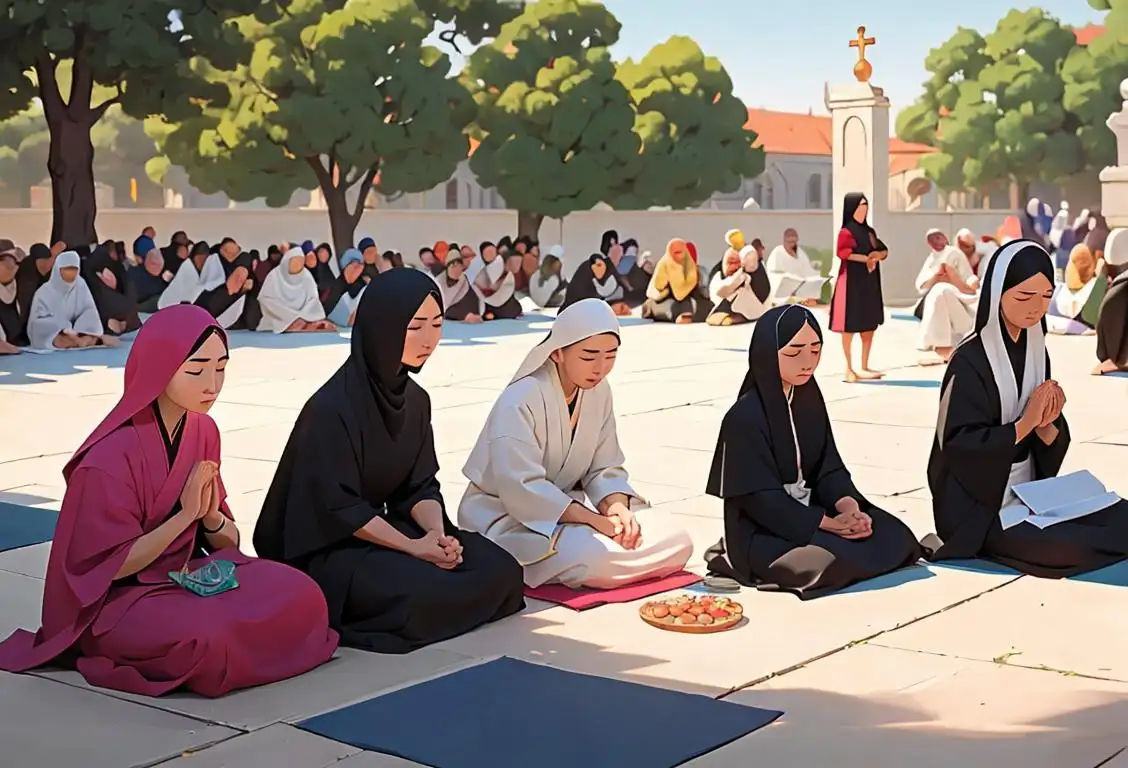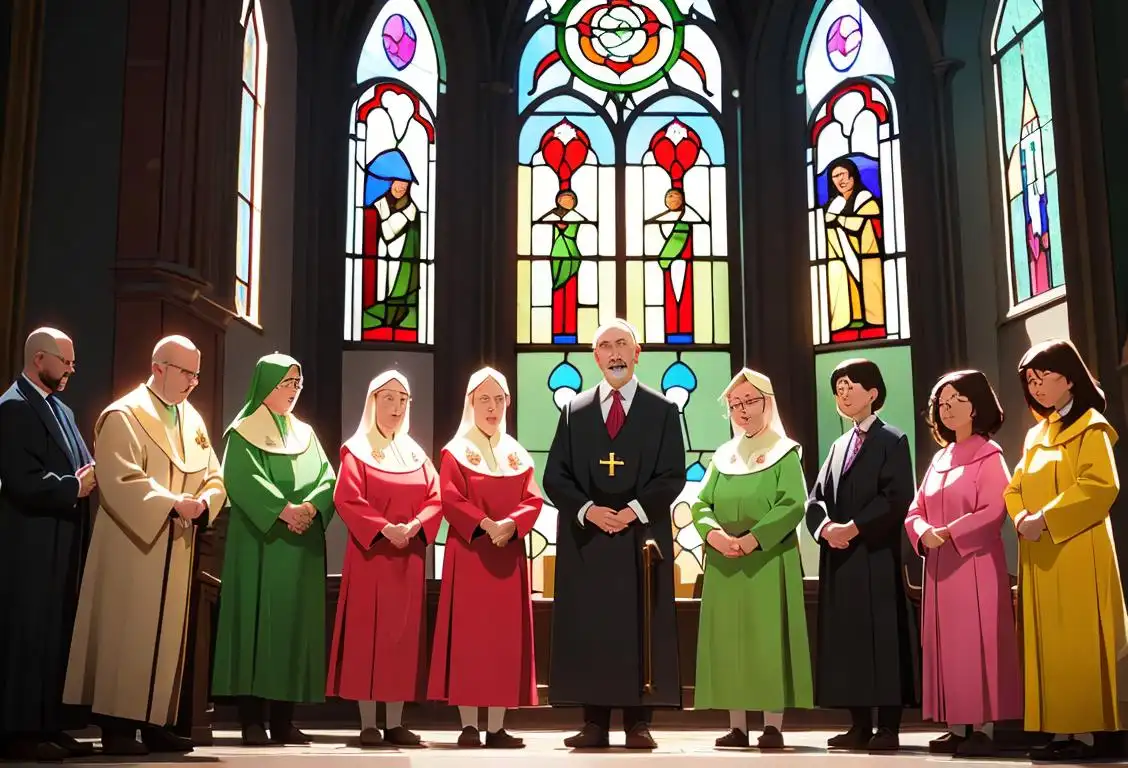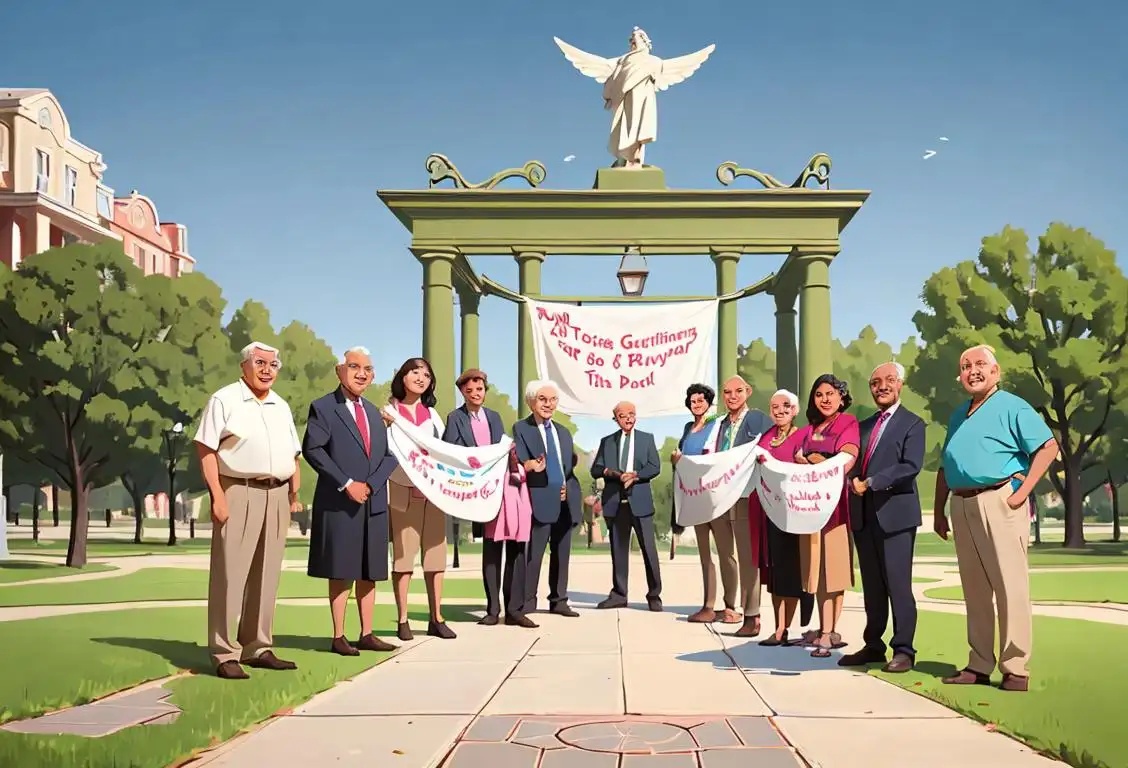National Back To Church Day

Hey there, folks! Are you ready to put on your Sunday finest and make your way back to church? Well, get ready, because National Back to Church Day is here to inspire us all to reconnect with our spiritual side and enjoy the warm embrace of community. So join me as we explore the internet history of this joyful day!
When is Back To Church Day?
It's national back to church day on the 12th September.
The Internet Journey of National Back to Church Day
National Back to Church Day is a special day dedicated to encouraging people to return to their local houses of worship and join in the fellowship and spiritual growth that comes with attending church. It's a chance for the faithful, the curious, and the wandering souls to embrace the beauty of faith and find solace in the company of others.
The origins of National Back to Church Day can be traced back to a grassroots movement that gained momentum with the rise of social media. People from all walks of life started sharing stories of how reconnecting with their faith transformed their lives and inspired them to spread the message of love and compassion.
On September 12, 2019, the internet exploded with discussions and announcements about National Back to Church Day. Social media platforms were buzzing with excitement as individuals and religious organizations planned events, special services, and outreach programs to welcome everyone with open arms.
The day itself is a reminder that we are never alone in our spiritual journey and that there is always a place for us within the warm embrace of a caring community. It encourages us to set aside our worries and doubts, and to rediscover the joy that comes from embracing our beliefs.
So, whether you're returning to church after a long hiatus or exploring this path for the first time, National Back to Church Day is a wonderful opportunity to connect with others, find guidance, and celebrate the power of faith.
History behind the term 'Back To Church'
1980
Rise of secularism
In the late 20th century, a growing trend of secularism was observed in many developed countries. People were becoming more individualistic and less connected to religious institutions. Attendance at churches declined, with many individuals searching for spirituality in alternative ways.
1880
The Origins of Church Attendance Decline
During the late 19th century, a significant decline in church attendance began in Western countries, particularly in Europe and North America. Various factors contributed to this decline, including changing social attitudes, scientific advancements, and the rise of secularism.
1997
The Birth of 'Back to Church Sunday'
In the year 1997, the term 'back to church' originated with the creation of 'Back to Church Sunday,' an initiative started by Michael Harvey, an Anglican priest in Manchester, England. The aim of this annual event was to inspire and encourage lapsed churchgoers to return to regular worship. This marked the beginning of a movement to reengage individuals with their faith and community.
1998
The Birth of the Back to Church Movement
The Back to Church movement originated in 1998 as a response to the declining attendance and waning interest in organized religious services. Churches across the United States noticed a significant drop in their congregations and sought ways to encourage people to return to church. The movement aimed to create a sense of community and revitalize faith by inviting individuals and families back to regular church attendance.
1870
The Rise of Church Attendance Decline
During the late 19th century, there was a significant decline in church attendance in many Western countries. Factors such as urbanization, industrialization, and the rise of secular ideologies contributed to this trend. People were becoming more disconnected from religious institutions, and church attendance was on the decline.
2008
Introduction of the term
In the year 2008, the term 'back to church' started gaining prominence. It was used to encourage individuals who had drifted away from attending church services to return and reconnect with their faith communities. The term aimed to emphasize the importance of congregational participation and highlight the spiritual benefits of attending church regularly.
1886
Rise of the Sunday School Movement
The first step in the history of the term 'back to church' can be traced back to 1886 when the Sunday School Movement gained traction. This movement aimed to provide education and religious instruction to children and adults who didn't have access to formal schooling. Sunday schools were set up in churches and became a gathering place for people to learn about the Bible and Christian principles.
1980
The Rise of Secularism
In the 1980s, there was a growing trend of people becoming less religious and attending church less frequently. This was due to a shift towards secularism and a decline in traditional religious practices.
1920
A Call to Return to Church
In 1920, amid the changing societal landscape and the progressive shift away from tradition, there was a growing concern about declining church attendance. As a response, influential religious leaders and theologians began advocating for a 'back to church' movement. They called upon individuals to reaffirm their commitment to attending religious services and reestablish a sense of community within their faith.
2004
The 'Back to Church' Movement Begins
In 2004, the 'Back to Church' movement emerged as a response to declining church attendance. The aim was to encourage lapsed Christians to return to regular church services, reconnect with their faith, and revitalize their relationship with the Christian community. This grassroots movement sought to reverse the trend of decreasing participation in organized religious activities.
1990
The Back to Church Movement
In the 1990s, some religious leaders recognized the need to bring people back to church and revitalize their faith. They started urging their congregations to return to regular church attendance and recommit to their religious beliefs.
2004
Expansion to 'Back to Church'
By the year 2004, the term 'Back to Church' had gained popularity as a broader concept beyond the specific event. It started being used more generally to encourage individuals who had stopped attending church to rediscover their faith and reconnect with their local congregations. This shift in usage allowed the term to encompass a wider audience globally.
1940
Back to Church Movement in the United States
In the early 1940s, a movement called 'Back to Church Sunday' emerged in the United States. This initiative aimed to encourage people who had stopped attending church to return and rediscover the spiritual benefits of regular worship.
2001
Back to Church Sunday campaign
To combat the decline in church attendance, the concept of 'Back to Church Sunday' was introduced by Michael Harvey, an Anglican priest from England. In 2004, he launched a nationwide 'Back to Church Sunday' campaign to encourage non-churchgoers to give it another try. The campaign aimed to create a welcoming environment and foster a sense of community among individuals who had drifted away from religious practices. The idea quickly gained popularity and started to spread beyond the United Kingdom.
2010
Rise of the Back to Church movement
By the year 2010, the concept of 'back to church' had sparked a movement within various religious denominations. Churches across the country began organizing special events and initiatives to welcome back lapsed congregants, inviting them to rediscover the joy of communal worship. The movement gained momentum as pastors and church leaders recognized the need to engage with individuals who had become disconnected from organized religion.
2002
National Back to Church Sunday
In 2002, the Back to Church movement gained further momentum with the introduction of the National Back to Church Sunday. This designated day, usually in September, was established as an annual event to encourage individuals who had stopped attending church or had never attended before to give it another try. The day served as a nationwide call for churches to proactively invite people to experience their services and embrace the sense of belonging and spiritual growth that comes with being part of a congregation.
2004
Back to Church Sunday Goes International
In 2004, 'Back to Church Sunday' became an international movement, spreading to various countries around the world. The initiative adopted a unified approach to help churches reach out to their communities and invite individuals to come back to church.
2010
Growing Awareness and Participation
In 2010, 'Back to Church Sunday' expanded its influence as more churches across various denominations embraced the movement. The event gained media coverage, and awareness about the importance of reconnecting with one's religious community steadily increased. People started recognizing the phrase 'back to church' as a gentle reminder to return to worship and experience the sense of belonging that comes with it.
2009
LifeWay Research Study
In 2009, a significant milestone for the Back to Church movement occurred when LifeWay Research conducted a comprehensive study on the reasons why people stopped attending church. The study aimed to uncover common barriers and objections to church attendance in order to address them effectively. The findings provided valuable insights for churches to tailor their outreach efforts and create an environment that would address people's concerns and attract them back to church.
2009
Creation of National Back to Church Sunday
In 2009, the movement gained further momentum with the establishment of National Back to Church Sunday. This annual event, observed on the third Sunday of September, encouraged churches across the United States to actively participate in inviting others to attend services and engage with their local congregations. The aim was to create a warm and welcoming environment for those who may have drifted away from regular church attendance.
2008
Back to Church Sunday
In 2008, a specific initiative called 'Back to Church Sunday' was launched in the United Kingdom. It aimed to encourage lapsed churchgoers to come back and invite their friends, family, and neighbors to attend church with them.
2012
National Back to Church Sunday
In 2012, 'National Back to Church Sunday' was officially established as an annual event in the United States. This special day aimed to encourage Christians to invite their friends, family, and neighbors who had strayed away from attending church back into their faith communities. It provided an opportunity for churches to showcase their welcoming and inclusive nature, offering a chance for reintroduction to the faith for those who had become disenchanted or disinterested.
1950
Post-WWII Spiritual Renewal
After the intense and traumatic period of World War II, there was a collective desire for spiritual renewal. Many servicemen and women returned from the war seeking solace and meaning in their lives. The term 'back to church' gained further popularity as communities sought to rebuild and find comfort in religious institutions, fostering a sense of stability and shared values.
2008
Global reach
The 'Back to Church Sunday' campaign expanded globally, with churches around the world adopting the idea. Its message resonated with people looking to reconnect with their religious roots and find a sense of belonging. The campaign emphasized personal invitations to friends, family, and acquaintances, encouraging them to come back to church on a specific Sunday. It aimed to remove any perceived barriers and create a warm and inclusive atmosphere for returning individuals.
2008
The Birth of 'Back to Church' National Day
In 2008, 'Back to Church Sunday' officially became 'Back to Church National Day,' a designated day for communities and churchgoers to actively engage in inviting and welcoming others who have drifted away from attending church.
2015
Expanding influence
As the years progressed, the 'back to church' movement expanded beyond the United States and gained international recognition. Churches worldwide began adopting similar initiatives to reach out to the unchurched and encourage them to reconnect with their spiritual roots. The term 'back to church' became a rallying cry for religious communities, reminding individuals of the benefits and sense of belonging that can be found within a faith-based congregation.
2014
Digital Outreach
With the rise of digital media, churches started embracing online platforms and social media to reach out to individuals who may have drifted away. In 2014, the Back to Church movement leveraged these technological advancements to expand its reach. Churches began utilizing websites, email marketing, social media campaigns, and online streaming of services to connect with a wider audience. This digital outreach offered convenience and flexibility to those who were hesitant or unable to attend traditional services, further encouraging them to reconnect with their faith community.
2010
Recognition as a national day
As the 'Back to Church Sunday' campaign gained momentum, churches and religious organizations started designating a specific Sunday each year as the official 'Back to Church Sunday.' This day served as a reminder for individuals to return to their faith and re-engage with their local religious communities. It became an annual tradition for churches to organize special events, services, and activities to welcome back those who had been away.
Present
Continuing Efforts to Encourage Church Attendance
The 'Back to Church' movement has persevered and continued to inspire efforts to revive church attendance. Churches worldwide have adopted similar initiatives to reach out to both lapsed Christians and those who have never been part of a religious community. These efforts often involve creating inclusive and engaging programs, organizing community events, and embracing innovative approaches to connect with individuals in the digital age.
1970
Revitalization Efforts
In the 1970s, amidst the cultural shifts of the counterculture era, churches faced a decline in attendance and relevance among younger generations. This prompted revitalization efforts with the aim of bringing people 'back to church.' New approaches were implemented to make religious services more engaging, inclusive, and relevant to contemporary issues. The term 'back to church' became a rallying cry for reviving religious communities.
2010
Global Spread of Back to Church
The Back to Church movement gained momentum and spread to various countries around the world. Similar events and campaigns were organized to promote church attendance and reconnect with the community.
Present Day
Global Reach and Virtual Adaptations
In the present day, 'back to church' has become a widely recognized term used internationally. The concept has expanded beyond physical church buildings, especially with the rise of online worship services and virtual communities. Recognizing the evolving needs of individuals, it now represents a call to reconnect with one's faith, regardless of geographical location or circumstances. The term 'back to church' has adapted to embrace both traditional and modern ways of experiencing spirituality.
Present
Continued impact
The concept of 'Back to Church' has become embedded in the cultural landscape, encouraging individuals to rediscover their religious beliefs and reconnect with their spiritual communities. While the exact date may vary from country to country and between denominations, 'Back to Church Sunday' remains an important annual event for churches worldwide. It serves as a reminder of the value of community, spirituality, and the ongoing quest for personal meaning in an increasingly secular world.
2008
National Back to Church Sunday
In 2008, a specific day was nationally designated as 'National Back to Church Sunday' in the United States. This initiative aimed to encourage churchgoers to invite their friends, family, and neighbors who had drifted away from attending religious services. The term 'back to church' became widely recognized as a call to action, reminding individuals of the importance of community, spiritual growth, and worship.
Present
Continuing the tradition
In the present day, the term 'back to church' continues to play a significant role in the effort to revitalize faith communities and bring individuals back into regular church attendance. It serves as a reminder of the importance of communal worship, spiritual growth, and the supportive relationships that can be nurtured within religious settings. 'Back to church' events, programs, and initiatives are still organized annually, emphasizing the ongoing commitment to welcoming and embracing all who seek to reconnect with their faith.
Present
Continued Efforts and Participation
Every year since its inception, 'Back to Church National Day' has witnessed participating churches organizing special events, services, and activities to reach out to both current and former church attendees. These efforts focus on fostering a sense of belonging, providing spiritual guidance, and building stronger connections within the community.
Today
Continued Efforts and Cultural Impact
The Back to Church movement continues to grow and adapt to changing times. Churches around the world recognize the importance of inviting people back to experience the power and support that comes from worshiping together. The movement's emphasis on community, acceptance, and personal growth resonates with individuals seeking spirituality and connection in their lives. By supporting the Back to Church movement, communities foster a sense of unity and compassion, reinvigorating faith and impacting countless lives in the process.
Present
Continuing Efforts
The Back to Church movement continues to evolve and adapt to modern times. Churches use various strategies, such as online outreach, community events, and personalized invitations, to reach out to those who have drifted away from regular church attendance.
Did you know?
Did you know that National Back to Church Day is not just limited to traditional church buildings? Many communities organize outdoor services, beach gatherings, and even online streams to accommodate different preferences and ensure that everyone feels welcome!Tagged
community spirituality faithFirst identified
20th September 2015Most mentioned on
12th September 2019Total mentions
20Other days
Rosary Rally In Washington Dc In Day
Back To Church Day
Call To Prayer Day
Baptist Day
Prayer And Fasting Day
Cheese Pizza Day
Law Day
Random Acts Of Kindness Day
Rum Day
Philanthropy Day








